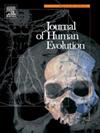A cadaveric study of wrist-joint moments in chimpanzees and orangutans with implications for the evolution of knuckle-walking
IF 3.1
1区 地球科学
Q1 ANTHROPOLOGY
引用次数: 0
Abstract
Understanding the mechanism underlying the evolution of knuckle-walking in African great apes but not in humans may provide important implications about the origin and evolution of human bipedal locomotion. In this study, aiming to reveal possible structural adaptations of the chimpanzee's forearm and hand musculature related to knuckle-walking, we measure the passive elastic moment of the chimpanzee's and orangutan's wrist as it was rotated into extension, immobilizing the metacarpophalangeal joint at three different positions: extended (as in knuckle-walking), flexed (as in fist-walking), and an intermediate position. Our findings demonstrate that when the metacarpophalangeal joints are extended, the rigidity of the wrist joint in the extended direction increases. This increased rigidity is attributed to the passive elongation and force generation of digital flexor muscles, which are relatively short in chimpanzees. Consequently, this enhanced wrist-joint rigidity contributes to the stability and energetically efficient transmission of propulsive force to the ground during the stance phase. Overall, our study supports the hypothesis that knuckle-walking is an adaptation to terrestrial locomotion for an ancestor characterized by the restricted capacity for wrist extension owing to the relatively shorter tendons of digital flexor muscles.
黑猩猩和猩猩腕关节力矩的尸体研究及其对指关节行走进化的影响。
了解非洲类人猿节肢行走的进化机制,而不是人类节肢行走的进化机制,可能会对人类两足运动的起源和进化产生重要影响。在这项研究中,为了揭示黑猩猩前臂和手部肌肉组织结构可能与指关节行走相关的适应性,我们测量了黑猩猩和猩猩手腕旋转到伸展时的被动弹性力矩,将掌指关节固定在三个不同的位置:伸展(如指关节行走)、屈曲(如握拳行走)和中间位置。我们的研究结果表明,当掌指关节伸展时,腕关节在伸展方向上的刚度会增加。这种刚性的增加归因于数字屈肌的被动伸长和发力,而黑猩猩的数字屈肌相对较短。因此,腕关节刚度的增强有助于在站立阶段将推进力稳定、高效地传递到地面。总之,我们的研究支持这样一个假设,即指关节行走是黑猩猩祖先对陆地运动的一种适应,这种适应的特点是,由于数字屈肌肌腱相对较短,腕关节的伸展能力受到限制。
本文章由计算机程序翻译,如有差异,请以英文原文为准。
求助全文
约1分钟内获得全文
求助全文
来源期刊

Journal of Human Evolution
生物-进化生物学
CiteScore
6.30
自引率
15.60%
发文量
104
审稿时长
3 months
期刊介绍:
The Journal of Human Evolution concentrates on publishing the highest quality papers covering all aspects of human evolution. The central focus is aimed jointly at paleoanthropological work, covering human and primate fossils, and at comparative studies of living species, including both morphological and molecular evidence. These include descriptions of new discoveries, interpretative analyses of new and previously described material, and assessments of the phylogeny and paleobiology of primate species. Submissions should address issues and questions of broad interest in paleoanthropology.
 求助内容:
求助内容: 应助结果提醒方式:
应助结果提醒方式:


